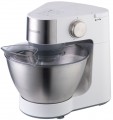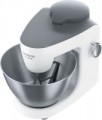Blender capacity
The volume of the blender jar (see Blender) that the food processor is equipped with. Standardly, it is about one and a half liters; for a large family, it makes sense to select a larger capacity (about 2 liters), and 1 liter will be enough if a blender is rarely needed and for small quantities of the product.
Power
Rated power of the food processor. Most of this power comes from the engine — the rest of the unit consumes very little energy. Usually, the
more power, the higher the productivity of the unit, and the less time it takes to process products.
Note that the optimal power value directly depends on the volume of the bowl (see the relevant paragraph): for example, for a 1.5 kg bowl, at least 300 W is desirable, for a two-kilogram bowl — 400 W, a three-kilogram bowl — at least 700 W. And with the same bowl capacity, a more powerful unit will be more productive, it will work faster and better cope with high loads (for example, a full load). On the other hand, an increase in power affects energy consumption and price.
Number of speeds
The number of fixed speeds of rotation of the attachments provided in the design of the food processor. The more of them, the more accurately you can choose the required speed for each specific mode of operation. It is worth noting that some devices do not have fixed speeds — the control is carried out smoothly (see Stepless speed controller)
Section for cord
A special section in the body of the device for storing the power cord. Often such sections are also come with devices for uniform winding of the wire, which prevents bending and possible fractures.
The cord section is especially useful if the food processor is used relatively rarely and stands idle for a long time outside the kitchen.

